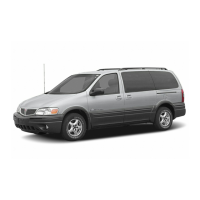
Do you have a question about the Pontiac 2004 Montana and is the answer not in the manual?
| Brand | Pontiac |
|---|---|
| Model | 2004 Montana |
| Category | Automobile |
| Language | English |
Covers adjustments for manual and power front seats, including seatback reclining.
Details rear seat operation, stowage, and features like flip and fold.
Explains proper use, fit, and importance of safety belts for all occupants.
Information on using child restraints, including older children and infants.
Explains the frontal and side impact air bag systems and their operation.
Guidance on periodically checking safety belts and child restraint systems.
Details about vehicle keys, including ignition and door lock functions.
Covers operation of door locks, power locks, and security features.
Information on power windows, rear quarter windows, and sun visors.
Explains anti-theft systems like PASS-Key® III and content deterrent features.
Covers new vehicle break-in, ignition positions, and starting the engine.
Details on manual and power rearview mirror adjustments.
Overview of OnStar services, including safety, security, and convenience.
Information on programming the HomeLink® transmitter for garage doors.
Locates and describes various storage compartments like glove box and console.
Customizing vehicle features like door locks and lighting.
Identifies main components of the instrument panel with references.
Explains the function and operation of hazard warning flashers.
Details operation of heating, cooling, and ventilation systems.
Describes warning lights and gages that signal vehicle function status.
Explains safety and maintenance messages displayed on the vehicle.
Covers operation, setting, and safe use of cruise control.
Information on operating headlamps, parking lamps, and fog lamps.
Details interior lighting controls, brightness, and overrides.
Explains the rear parking aid system and its operation.
Information on using vehicle power outlets for accessories.
Controls for rear climate adjustment without entertainment system.
Controls for rear climate adjustment with entertainment system.
Details on inspecting and replacing the passenger air filter.
Diagram and explanation of the vehicle's instrument panel cluster.
Explanation of speed display and odometer functions, including trip odometers.
Explains the function of the tachometer and its warning area.
Information on the safety belt reminder light and chime.
Explains the air bag readiness light and its meaning.
Details the brake system warning light and its implications.
Explains the ABS warning light and system checks.
Information on the traction control system warning light.
Explains the engine coolant temperature gage and its readings.
Information on the Service Engine Soon/Check Engine light.
Describes the fuel gage operation and common owner questions.
Explains safety and maintenance messages from the message center.
Describes the Traction Active message and its meaning.
Explains the engine coolant temperature warning message.
Details the charging system indicator message.
Explains the low oil pressure warning message.
Information on the engine oil change message and system reset.
Warning message for power sliding door status.
Indicates when a door or sliding door is not fully latched.
Indicates when the rear hatch is open.
Security message related to the PASS-Key® III system.
Warning message for the AWD system being disabled.
Alerts when the vehicle's fuel level is low.
Information display for vehicle status and surroundings.
Explanation of compass variance and how to set it.
Describes the self-calibrating compass system.
Procedure for manually calibrating the compass.
Explains error messages displayed by the vehicle's systems.
Information on trip computer displays and resetting.
Overview of the audio system, including installation and operation.
Procedure for setting the radio and clock time.
Details on operating the base level radio with CD player.
Information on XM satellite radio service and channels.
Instructions for operating the radio, volume, and sound settings.
Guidance on finding radio stations using tuning and seeking functions.
Procedure for saving favorite radio stations to preset buttons.
Adjusting bass, midrange, and treble settings for audio.
Selecting customized equalization settings for the audio system.
How to adjust speaker balance and fade for optimal sound.
Locating stations by program type using RDS and XM features.
Explains various RDS messages like ALERT!, INFO, and TRAF.
Lists and explains messages displayed by the XM radio system.
Instructions for inserting, playing, and managing CDs in the player.
Details on playing MP3 CDs and using Radio Data System (RDS).
Operation of radio functions including volume and seeking stations.
Guidance on tuning and scanning radio stations.
Procedure for saving favorite program types (PTY) to radio presets.
Overview of the DVD entertainment system, components, and operation.
Instructions for using wireless headphones with the entertainment system.
Information on operating and adjusting the video screen.
Details on the DVD player, its location, and controls.
Instructions for playing CDs and DVDs, including handling errors.
Control of music sources for rear seat passengers.
Using steering wheel buttons to control the audio system.
Information on AM and FM stereo reception and interference.
Proper handling and storage of CDs and DVDs.
General advice on safe driving practices and vehicle interaction.
Principles of defensive driving, focusing on anticipation and awareness.
Effects of alcohol on driving ability and consequences.
Explanation of systems controlling vehicle movement: brakes, steering, accelerator.
Details on braking action, perception time, reaction time, and stopping distances.
Explanation of the ABS system and its function in preventing skids.
Information on the traction control system and its operation.
Description of the automatic AWD system and its operation.
Covers power steering and tips for driving on curves safely.
Tips and techniques for safely passing other vehicles.
How to handle vehicle skids and avoid losing control.
Tips for safer driving during nighttime conditions.
Advice for driving safely in rain and on wet road surfaces.
Explanation of hydroplaning and how to avoid it.
Precautions for driving through deep water puddles.
Safety advice for driving through flowing or rushing water.
Tips for increasing safety and awareness in city driving.
Advice on freeway driving, including traffic flow and lane usage.
Checklist and advice for preparing your vehicle for long trips.
Tips and advice for safe driving during winter conditions.
Guidance on how to free your vehicle when it is stuck.
Information on towing your vehicle and recreational towing options.
Guidance on vehicle capacity weight and proper loading techniques.
Instructions and safety advice for towing a trailer.
General information on vehicle service and using GM parts.
Details on gasoline octane, specifications, additives, and foreign fuels.
Guidance on checking essential components under the hood.
Information on tire maintenance, types, and replacement.
Advice on selecting and purchasing new tires.
Tips for cleaning and maintaining the vehicle's interior and exterior.
Explains vehicle identification number (VIN) and engine identification.
Information on add-on electrical equipment and headlamp wiring.
Details on vehicle fuses, circuit breakers, and their locations.
Diagram and usage of fuses in the instrument panel fuse block.
Diagram and usage of fuses in the underhood fuse block.
Lists approximate fluid capacities and vehicle specifications.
Introduction to the maintenance schedule and GM Protection Plan.
Importance of following scheduled maintenance for vehicle condition and warranty.
How proper vehicle maintenance impacts the environment.
Guidance on how to use the maintenance schedule based on driving habits.
Routine owner checks and services for vehicle upkeep.
Details on Maintenance I and Maintenance II schedules based on oil life system.
Specific services required at mileage intervals.
Explanations and details related to scheduled maintenance items.
Overview of customer assistance resources and contact methods.
Information on reporting safety defects to government agencies and GM.
Steps to follow if a dealership concern is not resolved.
Resource for vehicle information, service reminders, and dealer lookup.
Assistance for customers using Text Telephones (TTYs).
Contact information for customer assistance in the United States.
Details on roadside assistance services provided to owners.
Information on courtesy transportation options during warranty repairs.
Explanation of vehicle computer systems and data collection.












